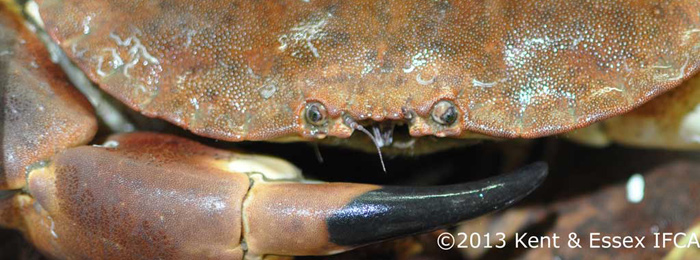01843 585310
info@kentandessex-ifca.gov.uk

01843 585310
info@kentandessex-ifca.gov.uk

Cancer pagurus Brown crab is the largest of the crab species in UK waters reaching sizes up to 25 cm carapace width. They have an oval shaped carapace which looks like a crimped pie crust. Brown crab also usually have two large front claws with black tips which it uses to grip onto objects, prey and as an aggressive defensive tool. They are commonly found on rocky hard substrata but also on mixed coarse and sometimes muddy sand sediments, ranging from mid-tide level to depth of up to 100 m. Edible crabs are an aggressive predator of most benthic mollusc and echinoderm species that are smaller than the individual.
They are also keen scavengers of fish species and carrion which is available to them on the sea bed. Juvenile individuals and males will tend to remain inshore all year round while adult females will migrate inshore during late spring to moult and mate before moving offshore again in late summer for the rest of the year. When not feeding during night hours, crabs will tend to hide from predators under any available forms of fixed shelter as well as partial burying into muddy substrate. Hen crabs will generally starve throughout the duration of the time they are carrying egg masses on their underside until hatching occurs. Although crabs grow to be a large predator capable of defending themselves with strong claws, the survival rate of the pelagic larval stages prior to final metamorphosis and settlement on the sea bed where juveniles can hide is low due to high predation levels from pelagic species.
Once on the sea bed, juveniles and moulting soft shelled crabs are again susceptible to predation when out foraging from a wide variety of predators including commercially important species.
© Kent & Essex IFCA 2026 - All Rights Reserved | Privacy Policy